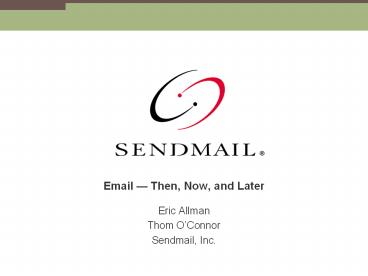Email PowerPoint PPT Presentation
1 / 14
Title: Email
1
Email Then, Now, and Later
- Eric Allman
- Thom OConnor
- Sendmail, Inc.
2
A (Very) Brief History of Email
- Email springs from the ArpaNET as an afterthought
special form of file transfer - Slow networks, low volume, limited audience
(academic and research) - Quickly became a killer app
- 1984 Internet appears, still limited audience
- April 30, 1995 The rules change Internet is
privatized net becomes available to anyone with
money for any purpose - Some privately held backbones prior to this, but
limited commercial use because of government
rules - Email becomes a critical part of the business
infrastructure
3
Where Are We Right Now?
- Good (but could be better) timely, anywhere
access, reasonable marginal cost, ability to file
and store, searchable (sort of), can auto-handle,
elements of privacy and reliability - Not so good spam and viruses are here to stay
- When theres money to be made, people will figure
out how to make money - Think of spam as roaches you can keep them under
control but not eliminate them (Dave Crocker) - Commercial entities want to use email to supplant
physical mail bills, statements, ads, trade
acknowledgements, etc. - Traffic load keeps going up this isnt going to
change even when we fix the spam problem
4
Pressures Placed on Email Today
- Summary better control and access, more secure,
reliable, and flexible - Message filtering and filing capabilities on the
server brought down to the end-user level (better
control) - Integration of wireless access with traditional
methods of access (better access) - Synchronization of data regardless of access
method (more flexible) - Message validity and classification (more secure,
more reliable)
5
Better Control
- Message filtering and filing capabilities
- First came anti-virus, content filtering, and
anti-spam basics on a site-wide level - Soon after, it was Classes of Service, with
different groups of users with different needs - Now its complete per-user control
- SIEVE filtering and fileinto (RFC 3028)
- SMS notification and forwarding
- User-based classifications of what is valid and
not valid (spam) email - Need to push per-user controls out to the
perimeter
6
Better Access
- Everything going wireless and everyone going
mobile (obvious) - Security (and privacy) of information is a major
challenge - The basic protocols exist to provide the access,
but not easily assembled HTTP/HTTPS,
IMAP/IMAPS, WAP, iMODE, RSS, WebDAV, and a mix of
proprietary protocols (e.g., Blackberry) - Users want all functions on all devices
7
More Secure
- Everyone talks the security talk, but not enough
walk the security walk - Some ISPs block or redirect outgoing port 25
- Challenges interoperability (PKI, certificate
management), MUA (client) implementation
differences, ease of use, corporate enforcement
policy - Being driven by legal and policy issues
- SEC, HIPPA, Sarbanes-Oxley
- Continued slow growth of STARTTLS and SMTPS,
IMAPS, POPS, Public Key encryption (PGP
S/MIME), HTTPS - Still need a trigger to kick-start wider usage of
encryption in email
8
More Reliable
- The clear need for authentication
- Sender domain authentication is the necessary
precursor to the next big thing in email - Authentication introduces accountability, message
identification, and prioritization - Service providers will need to have their users
authenticate before submitting mail (RFC 2476)
transitive accountability - The best authentication is one based on proven
security techniques such as SMTP AUTH (RFC 2554)
9
What You Should Think AboutWhen Designing an
Email System Today
- Scaling for the present and the future
- Regulatory compliance
- Reliability appropriate for your needs
- E.g., redundancy if necessary (but expensive)
- Resilience against Denial of Service attacks
- Flexibility to do what you need
- Dont get caught up in a single litmus test
- People are more expensive than silicon move work
from people to computers wherever possible
10
Predictions about the Future (23 years)
- Obvious
- Volume will continue to go up for quite some time
- Spam will be better addressed, albeit not fixed
- Companies will separate their mail based on class
and outsource a lot of it - Bill presentment, advertisements, newsletters,
etc. - Personal exchange with customers, partners, and
colleagues will be treated separately and
differently - Legal landscape will change e-information will
be held to stricter standards than paper - Mail will move toward IM but not fully merge
- SMTP will morph, but there will be no serious
contender for replacement
11
Spam Predictions (Next 23 Years)
- ePostage wont succeed for several years
- User resistance
- Vendor bickering
- Pragmatic problems
- Authentication techniques will help dramatically,
but will not solve the problem by themselves - Fraud will be directly addressed and reduced
- Spammers will adapt to the extent they can, but
they will be more exposed - Accreditation/Reputation systems will gain a
foothold, but not globally value will be
debatable - Most pure content-filtering techniques will
stumble because they just cant keep up
12
Problems Without (Current) Solutions
- Enforcing encryption by the message recipient (I
dont want to accept unencrypted mail from
Travelocity) - Automated outgoing encryption (per domain and/or
per recipient) available on a limited basis - Better PKI DNS use for key distribution may not
scale well, especially to larger keys - MUA support for new functionality e.g., display
authentication status Microsoft is doing some
13
Conclusions
- Email is not dead, far from it expect more, much
more but dont ignore serious challenges - SMTP is not dead, but it will change to meet the
demands (e.g., SUBMITTER extension) - Authentication will be a major and important
change, but wont immediately do as much as we
would like - Spam will be dealt with, albeit not without cost
to both legitimate senders and receivers - Dealt with doesnt mean annihilation, just
reducing it to a dull roar
14
Questions?

